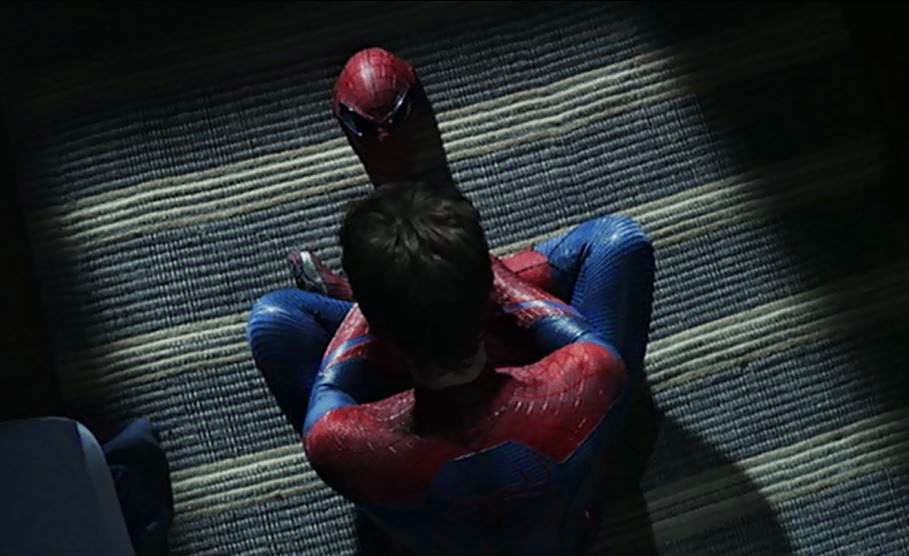The Amazing Spider-Man is a slightly different type
of superhero film. It is not primarily about Spider-Man - who does not appear
fully within the movie's first fifty-four minutes - instead focusing on the man
beneath the mask, Peter Parker. Though most superpowers or powered suits are
extensions of the users, Spider-Man has an entirely different outward
personality from Peter. To pull this off, the writers had to focus extensively
on the human characters in order to rouse the support and sympathy of the
audience.
Peter is very approachable, yet standoffish enough that he
does not easily make friends. He is striking while generally blending in. Note
that Flash is mean to him only because Peter treats him like he is inferior,
and that is only because Peter wants to save others from Flash's bullying by
making himself the target. As Peter purges his frustrations through his deeds
as Spider-Man, he becomes more of a visible high school presence (in multiple
ways) and shifts his wardrobe from heavy layers to T-shirts. His superhero
persona allows his anger and dejection to be lessened, initially through
vigilantism and later through his accepting his role as a heroic figure. One
gets the sense that without an outlet, Peter would be a mopey, lonely teen.
Another major factor in his personality growth is his relationship with Gwen.
Gwen Stacy is a likable female protagonist and a woefully
uncommon one. She is extremely intelligent - top of her class, Oscorp intern,
first seen reading Vonnegut - while being feminine and flirtatious. This even
extends to her wardrobe. Instead of high heels and high-maintenance hair, she
sports practical boots and pulled-back 'dos. Rarely do movies feature heroines
brighter than the (super)heroes, Harry Potter's Hermione being the most
famous example. Gwen's position as an intern to Dr. Connors also allows
her to be integrated into the main conflict in an organic manner.
Dr. Curtis Connors is probably the most complex character
amidst the proceedings. His back story is one of loss like Peter's, yet those
he has lost and his methods of coping are very different. Where Peter turns to
heroism, Connors shifts to villainy that he believes is heroism. Peter
is haunted by the deaths of his parents and later uncle; Connors has driven his
wife and child away due to his fixation on his missing right arm. He still
wears his wedding ring and (a questionably canon) deleted scene reveals that he
has a young son. His fallible humanity spurs his transformation into Lizard,
which manages to walk a fine line between evoking empathy and revulsion.
Lizard has regenerative capabilities, making a battle
against him nearly impossible to win. He can be temporarily halted by freezing,
yet Spider-Man cannot defeat him while his serum is still working. Spider-Man
must rely on evasion in Lizard's underground lair, during the school fight, and
in the skirmish on Oscorp Tower's roof. Instead of the typical hand-to-hand or
weaponry melee, ASM's action sequences rely on blocking and escaping,
with a lot of webs expelled and swung upon. While this could be tiring, the
changes in location and strategy keep each scene unique while allowing classic
comics-Spidey poses to emerge.
There is also an extended build-up to the final scuffle with
Spider-Man's journey across New York's cranes. While the prominent American
flag is heavy-handed and James Horner's score sounds entirely too similar to
James Cameron's Titanic setting sail, it's a flashy sequence. There are
angles and takes that would be impossible in a non-CG environment, but
Spider-Man's movement is very normal and his appearance is consistent with the
rest of the film. Gone are the noodle people and shoddy texturing of the early
2000s. It's a smart mix of unreal and real, and all else falls away to showcase
Spider-Man in all his web-swinging glory. For a minute, Marc Webb reminds
viewers why they go see movies in the first place, to feel that sense of wonder.
The Amazing Spider-Man is a beautiful, heady love
letter to cinema and Spider-Man, reinventing the characters while serving as a
potent reminder of why they are held so dear. The setting and designs may be
modern, yet the romance and themes of acceptance and betrayal are timeless.
Spider-Man's mythos has always been concerned first and foremost with the
growth of its characters and never has that focus been more rewarding than in
this film.
Miscellaneous:
- Spider-Sense is not visualized in the movie, though a
sound effect indicates that Peter has perceived something.
- One police officer investigating Uncle Ben's murder
erroneously states that the killer has a tattoo on his hand in voiceover, while
the video clearly shows that the tattoo is on the man's wrist.
- For no apparent reason, there's some obvious ADR when
George Stacy tells Peter to "go back to [hang] out with the citizens of
Tokyo", his mouth clearly forms the word Japan instead of Tokyo.
- There are two nods to The Social Network, another
Sony/Andrew Garfield project. Garfield's characters in both films give powerful
men algorithms that they then use to alter the world around them. Also, the
Oscorp secretary expresses doubt that Peter would be named Rodrigo Guevara. In The
Social Network, Garfield's played the Hispanic Eduardo Saverin.
- Connors's initial reformed hand strongly resembles matter
made from the Flesh from the Doctor Who story The Rebel Flesh/The
Almost People.







No comments:
Post a Comment